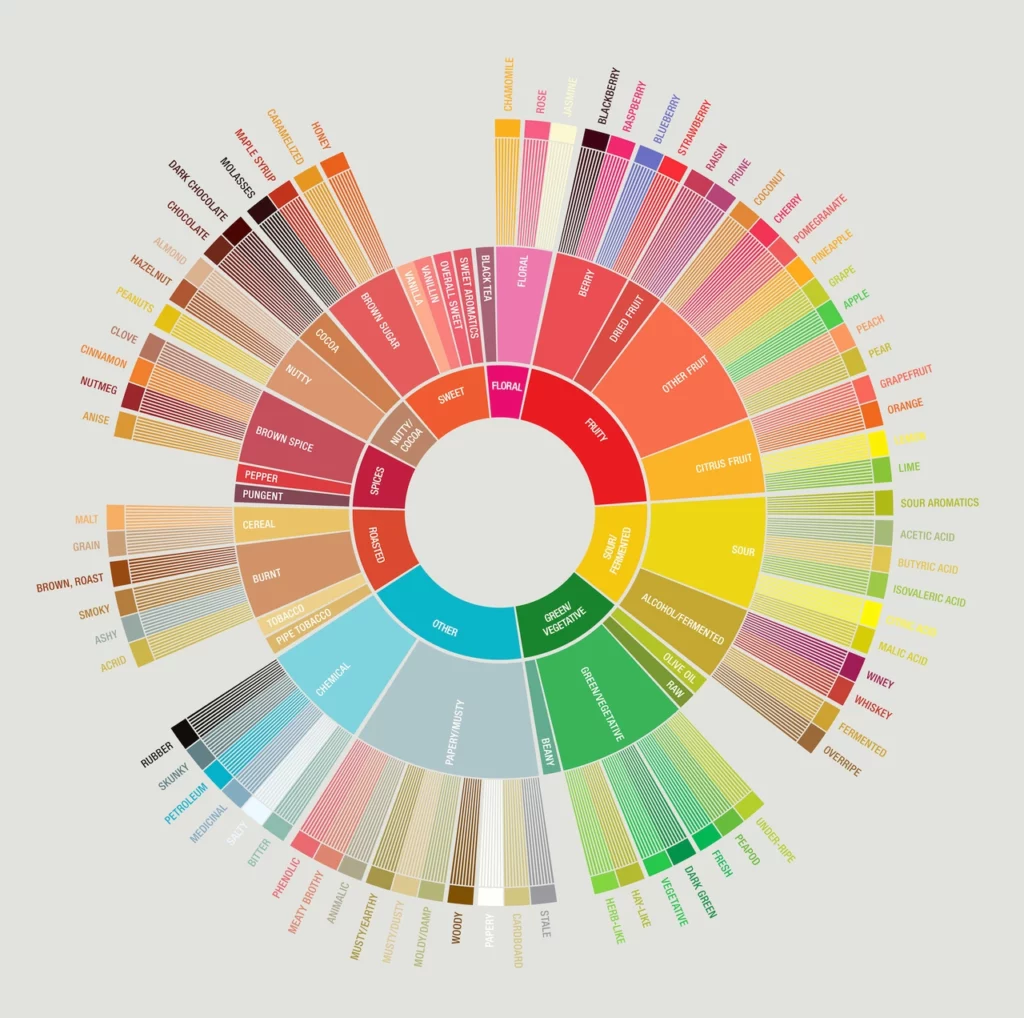What is the SCAA Flavour Wheel?
The Specialty Coffee Association of America (SCAA) Flavour Wheel, also known as the Coffee Taster’s Flavor Wheel, is a visual tool used in the coffee industry to describe and categorize the various flavors and aromas found in coffee. It was developed by the SCAA as a standardized method to communicate and evaluate coffee flavors.
The SCAA Flavour Wheel is divided into three main levels: the center, the intermediate level, and the outer level. Each level represents a different level of detail in describing coffee flavors.
- Center Level: The center of the wheel represents broad flavor categories that are used to describe the overall character of the coffee. These categories include descriptors such as Sweet, Sour, Salty, Bitter, and Fruity.
- Intermediate Level: The intermediate level provides more specific descriptions within each broad category. For example, under the “Fruity” category, you might find descriptors like Berry-like, Citrusy, or Tropical Fruit.
- Outer Level: The outer level of the wheel provides even more detailed descriptions of specific flavors. It includes descriptors like Blueberry, Lemon, or Pineapple.
By using the SCAA Flavour Wheel, coffee professionals and enthusiasts can better communicate and identify the specific flavors and aromas present in a particular coffee. It helps in evaluating coffee quality, identifying defects or desirable attributes, and facilitating discussions about coffee flavour profiles.

How Do You Use the SCAA Flavour Wheel?
- Start with an aroma or flavor: Begin by smelling or tasting the coffee and try to identify a specific aroma or flavor that stands out to you.
- Determine the broad category: Look at the center level of the wheel and identify the broad category that best matches the aroma or flavor you have identified. For example, if you taste something sweet, it would fall under the “Sweet” category.
- Refine the description: Move to the intermediate level of the wheel and explore the descriptors within the chosen category. Select the term or terms that best describe the aroma or flavor more precisely. For instance, if you identified a fruity note, you can further specify it as “Berry-like” or “Citrusy.”
- Specify further if necessary: If you want to provide even more detail, move to the outer level of the wheel. This level contains more specific descriptors that can help you narrow down the flavor or aroma. Select the terms that accurately represent the nuanced qualities you perceive.
- Repeat as needed: If you identify multiple flavors or aromas, you can repeat the process by starting from the center level and working your way outwards for each distinct characteristic.
By using the SCAA Flavour Wheel, you can articulate and communicate the flavors and aromas you perceive in coffee in a standardized manner. It helps in sharing tasting notes, comparing different coffees, and facilitating discussions among coffee professionals and enthusiasts.
Where Did the SCAA Flavour Wheel Come From?
The SCAA Flavour Wheel was first introduced by the Specialty Coffee Association of America (SCAA) in 1995. It was developed by an industry-wide collaboration of coffee professionals, sensory scientists, and researchers. The purpose was to create a standardized tool that could be used to describe and communicate the complex flavors and aromas found in coffee.
The original SCAA Flavour Wheel underwent revisions and refinements over the years to improve its accuracy and comprehensiveness. In 2016, the SCAA, along with the Barista Guild of America and World Coffee Research, released an updated version of the Flavour Wheel, which included additional descriptors and more detailed categorization.
Since its introduction, the SCAA Flavour Wheel has become widely used in the coffee industry, including by coffee roasters, baristas, coffee tasters, and enthusiasts. It has become a common reference point for evaluating and discussing coffee flavour profiles and has helped to create a shared vocabulary for describing coffee’s sensory attributes.




